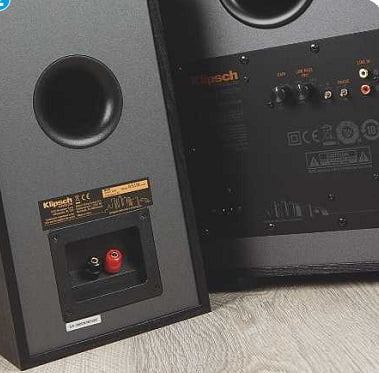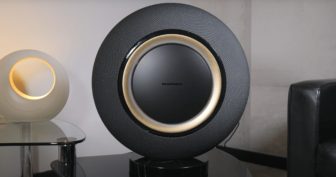KLIPSCH REFERENCE 5.1.2 SYSTEM
Horn-loaded high jinx
Klipsch is back in the UK with its all-new Reference series and Ed Selley thinks it means business
Some speaker brands change their design language to suit the current mood, opting for whatever the prevailing trends suggest is working with the public. Others find the solutions they like and stick with them – US brand Klipsch might as well be the poster child for the latter approach. Established in 1946, it has employed many of the same technologies ever since.

- 5.1.2 floorstanding speaker system
- Next to Atmos- integrated models in Klipsch’s home theatre stable
- Elipson Prestige Facet; Monitor Audio Bronze
The new Reference Series auditioned here is slightly confusingly named because it is neither the flagship lineup in the Klipsch stable (the Reference Premiere is above it) nor the only models so titled. It comprises three floorstanders, two standmounts (with powered variants of those available too), two centres, two subwoofers and an upward-firing module that can be used on top of the front and rear speakers.
Our system features the R-620F floorstander (the middle of the three available), the R-51M standmount and the R-34C centre. These are joined by the R-41SA effects speaker and R-100SW subwoofer.
What ties the range together – and is a defining characteristic of Klipsch products going back 70 years – is the tweeter. This is horn-loaded, a practise that’s fairly uncommon in this day and age. Here, the tweeter is mounted deep inside a square ‘Tractix’ horn assembly recessed into the cabinet front. This turns the tweeter into a compression driver, making use of the horn aperture to correct the difference in air-pressure loading between the driver and the air in front of it. This helps sensitivity and aids dispersion. Klipsch partners the horn-loaded tweeter with a copper-coloured injection-moulded graphite (IMG) driver. The front, centre and rear speakers are all ported for improved bass response.
Slender centre
The R-34C centre speaker is perhaps the most unusual of this system’s components. To reduce its height and simplify placement, it is fitted with four 3.5in midbass drivers and a horn tweeter, which means it’s only 13cm tall but a more considerable 66cm wide. While it looks a little odd. it’s commendably clear thinking and the radiating area of the four drivers is equivalent, explains Klipsch. to a brace of 6.5in units. The only area of mild concern is that it contributes to a situation where every speaker in this surround sound pack uses a different-sized main driver, which goes against the notional ideal.
The partnering R-100SW sub adds another driver to the complement although this is to be expected. Its 10in IMG woofer, also copper-coloured, is powered by a 150W (300W peak) Class D amplifier in a rear-ported cabinet.
The final R-41SA upfiring speaker completes the pack and still manages to locate a horn tweeter into a compact enclosure alongside a 4.5in midbass. It has its own terminals, so can be used with any speaker rather than being tied to specific Klipsch models.

Whether or not you like the styling will be a matter of personal taste. I think the speakers are handsome-looking things and the fit and finish is extremely good – there’s a no-nonsense quality to them that hopefully lends them a little timelessness. Yet I know some will struggle to be won over by the copper drivers and will feel the need to hide them with Klipsch’s grilles. It would be nice to have a finish other than black, too – and if black is the only option.
I don’t really understand why you’d texture it to look like wood, but it is at least well applied.
Anyway, there’s more to a loudspeaker than what it looks like…
Like it loud
Horn-loaded tweeters came into being in part because they increased the sensitivity of a speaker – useful in the time of valve amps. This Reference Series array hasn’t lost this trait (the R-620F’s sensitivity rating is 96dB) and needs very little power to go meaningfully and impressively loud. This in turn lends an effortlessness to their presentation that really helps with largescale events.
They don’t get much larger than the detonation of the drones by the USS Franklin in Star Trek Beyond (Blu-ray). and with this sequence these speakers are in
- All the speakers feature horn-loaded tweeters-a Klipsch speciality
their element. The overrunning wave of drones is well captured in the Atmos height channels and the system walks the fine balance of conveying the vast numbers involved while still picking out individual details. Information is moved around slickly from speaker to speaker and the wide dispersion ensures that the effect is a seamless and unbroken soundfield.
The biggest surprise in the pack is the slim R-34C centre. It fulfils its role admirably. Dialogue is always clear and easy to follow and there was rather more weight and scale than I was expecting. Crucially, despite the rather different configuration between it and the left and right enclosures, the LCR stage sounds impressively integrated in a way that even some more expensive packages I have heard have struggled with.
The sonic results are convincing. There’s scale and impact here that ensures a cinematic performance
With the complex sequence in Atomic Blonde (Blu-ray) where Lorraine and Spyglass attempt to escape to the West, the Klipsch excels. Crowd scenes are packed with sonic details that are resolved very effectively – I felt I was in the midst of a mass of people. One of the reasons why this is as convincing as it is comes down to the ability of all the main speakers (and to an extent, the height channels as well) to impart a sense of weight in their own right. Lower mid-tones/upper bass registers are robust, and the benefit this grants the pack is considerable.
When the woofer is really called into action, it proves to be a fine performer that complements the passive models well. The detonation of explosive charges that sets off the attack on Scarif in Rogue One: A Star Wars Story (Blu-ray) is a case in point. Despite the meagre specification, the R-100SW delivers LFE that is felt as well as heard and does so with an absence of bloat or overhang. It seems Klipsch has worked hard to ensure that the cabinet, amplifier and driver work together in a manner that is greater than the sum of its parts. Under all but the more appalling provocation it stays controlled and agile. Given that the passive speakers are as sensitive as they are and that high listening levels are easy to achieve, it does a brilliant job of keeping pace. Often, any review of a package around this price will suggest looking at a woofer from a dedicated manufacturer, but I’m not sure that’s applicable here.
Bang for your buck
It’s hard to think of systems that come in at a similar price that offer demonstrably more bang for your buck than this one. Klipsch’s cabinets aren’t small and their rear-ported designs will work best with the speakers given a little space, but their sensitivity and exceptional integration will win many over. There’s scale and impact here that ensures a cinematic performance, and when the sonic results are this convincing, aesthetic concerns (such as the driver colour and angular design of the upfiring models) begin to fade away
VERDICT
SPECIFICATIONS
R-620F
DRIVE UNITS: 2 x 6.5in IMG woofers; 1 x 1in Tractix tweeter ENCLOSURE: Ported FREQUENCY RESPONSE (CLAIMED): 38Hz-21kHz SENSITIVITY (CLAIMED): 96dB POWER HANDLING (CLAIMED): 100W DIMENSIONS: 240(w) x 1,017(h) x 386(d)mm WEIGHT: 18.6kg
R-51M
DRIVE UNITS: 1 x 5.25in IMG woofers; 1 x lin Tractix tweeter ENCLOSURE: Ported FREQUENCY RESPONSE (CLAIMED): 68Hz-21kHz SENSITIVITY (CLAIMED): 93dB POWER HANDLING (CLAIMED): 85W DIMENSIONS: 178( w) x 338(h) x 215(d)mm WEIGHT: 5 kg
R-34C
DRIVE UNITS: 4 x 3.5in IMG woofers; 1 x lin Tractix tweeter ENCLOSURE: Ported FREQUENCY RESPONSE (CLAIMED): 82Hz-21kHz SENSITIVITY (CLAIMED): 96dB POWER HANDLING (CLAIMED): 100W DIMENSIONS: 660(w) x 133(h) x 157(d)mm WEIGHT: 5.6kg
R-41SA
DRIVE UNITS: 1 x 4.5in IMG woofer; 1 x lin Tractix tweeter ENCLOSURE:
Ported FREQUENCY RESPONSE (CLAIMED): N/A SENSITIVITY (CLAIMED): N/A POWER HANDLING (CLAIMED): 50W DIMENSIONS: 146(w) x 180(h) x 331(d)mm WEIGHT: 2.7kg
R-100SW (subwoofer)
DRIVE UNITS: 1 x 10in forward-firing IMG woofer ENCLOSURE: Ported FREQUENCY RESPONSE (CLAIMED): 32Hz-120Hz ONBOARD POWER (CLAIMED): 150 W REMOTE CONTROL: No DIMENSIONS: 318(w) x 368(h) x 417(d)mm WEIGHT: 10.9 kg FEATURES: LFE input; stereo phono input; volume, crossover and phase control
PARTNER WITH
MISSION: IMPOSSIBLE- FALLOUT: Another fine slice of high-octane espionage fun arrives on Blu-ray with an immersive Dolby Atmos soundmix that consistently peppers the listening position with crisp FX. See p94 for our review.
- 2. The R-100SW offers standard LFE/stereo phono connections






